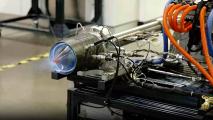NASA is funding the development of a network of AI-controlled space lasers to zap orbital debris. If it works as hoped, it could automatically redirect any space junk on a collision course with spacecraft — including those containing astronauts.
Space junk: Thanks to cheaper launches and smaller satellites, it’s never been easier to reach space. The upside is space factories, microgravity research, and globe-spanning internet networks. The downside is way more space junk.
A collision with even a tiny piece of space junk could seriously damage a NASA spacecraft.
Also known as “orbital debris,” space junk is all the hardware humans have sent up into space but didn’t retrieve. Today, there are millions of pieces of it orbiting our planet, ranging in size from defunct satellites and rocket parts down to rogue screws and flecks of paint.
Because this space junk is moving so fast — often roughly 15,000 mph, or ten times the speed of a bullet — a collision with something as small as a pencil eraser could seriously damage an operational satellite or, even worse, a crewed spacecraft.
This is a growing risk in itself, but there’s also a risk that a major collision in space could spawn a chain reaction that takes out a large number of satellites and even makes some orbits totally unusable.
Earth’s orbit is expected to get even more crowded in the near future, too. SpaceX and Amazon each plan to deploy thousands of new satellites for their internet-beaming mega-constellations over the next few years, not to mention all the other companies in the growing space economy.
“Several lasers can act simultaneously on a single target.”
Hang Woon Lee
What’s new? Figuring out what to do about orbital debris is a priority for NASA — it’s already exploring the use of space tugs, robotic claws, inflatable trash bags, junk-trapping nets, and more to collect junk or move it out of Earth’s orbit.
Now, NASA has awarded Hang Woon Lee, director of West Virginia University’s (WVU) Space Systems Operations Research Laboratory, up to $600,000 to develop AI-controlled space lasers to zap orbital debris that threaten its operational spacecraft.
AI space lasers: The system is still in the early stages of development, but the idea is to mount lasers on multiple platforms in space.
If the algorithms controlling the lasers determine that a piece of junk is likely to collide with a space asset, they’d fire one or more lasers at the debris. The idea isn’t to blow up the space junk — that would just turn one piece into many smaller pieces — but just to nudge it onto a safer path.
“Using a system of multiple lasers can create multiple engagement opportunities with debris and lead to more efficient control of the trajectories,” said Lee. “Several lasers can act simultaneously on a single target at a greater spectrum of intensity, altering its trajectory in a way that would be impossible with a single laser.”
Looking ahead: Developing the system won’t be easy. The algorithms will need to be able to analyze the size, shape, and orientation of a piece of space debris to determine the best way to nudge it — and a miscalculation could set the junk on an even more dangerous course.
Lee will now have up to three years of funding from NASA ($200,000 per year) to design the space laser network and the algorithms that will control it, which he plans to validate using a “digital twin environment.”
Because the system doesn’t actually remove space junk from Earth’s orbit, it alone can’t solve the problem, but it could help redirect pieces too small for other strategies, making it a potentially valuable addition to NASA’s future arsenal of debris-removing tech.
We’d love to hear from you! If you have a comment about this article or if you have a tip for a future Freethink story, please email us at [email protected].




